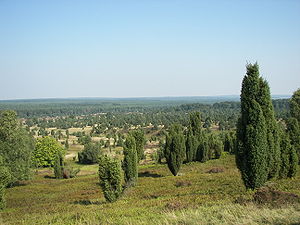
Push moraine
Encyclopedia

Geomorphology
Geomorphology is the scientific study of landforms and the processes that shape them...
a moraine
Moraine
A moraine is any glacially formed accumulation of unconsolidated glacial debris which can occur in currently glaciated and formerly glaciated regions, such as those areas acted upon by a past glacial maximum. This debris may have been plucked off a valley floor as a glacier advanced or it may have...
(a landform
Landform
A landform or physical feature in the earth sciences and geology sub-fields, comprises a geomorphological unit, and is largely defined by its surface form and location in the landscape, as part of the terrain, and as such, is typically an element of topography...
formed by glacial
Glacier
A glacier is a large persistent body of ice that forms where the accumulation of snow exceeds its ablation over many years, often centuries. At least 0.1 km² in area and 50 m thick, but often much larger, a glacier slowly deforms and flows due to stresses induced by its weight...
processes) that forms when the terminus advance of a lowland glacier pushes unstratified glacial sediment into a pile or linear ridge in front of it. A push moraine is identified by its ability to push sediment upwards from its original horizontal position. Push moraines are limited in size by the advance of a glacier front and its tendency to shear over the top of any ridge large enough to resist the movement of ice. Pushed moraines generally occur in low, flat plains at higher latitude
Latitude
In geography, the latitude of a location on the Earth is the angular distance of that location south or north of the Equator. The latitude is an angle, and is usually measured in degrees . The equator has a latitude of 0°, the North pole has a latitude of 90° north , and the South pole has a...
s and were formed during the glacial stages of the Quaternary ice age
Quaternary glaciation
Quaternary glaciation, also known as the Pleistocene glaciation, the current ice age or simply the ice age, refers to the period of the last few million years in which permanent ice sheets were established in Antarctica and perhaps Greenland, and fluctuating ice sheets have occurred elsewhere...
. They can be up to 100 km long and several hundreds of meters in height.
Pushed moraines can be found in the North American plains, in Siberia
Siberia
Siberia is an extensive region constituting almost all of Northern Asia. Comprising the central and eastern portion of the Russian Federation, it was part of the Soviet Union from its beginning, as its predecessor states, the Tsardom of Russia and the Russian Empire, conquered it during the 16th...
and in Northern Europe. They were formed during cool, glacial stages, when glaciers advanced and covered large parts of North America and Eurasia. In some regions pushed moraines of more than one glacial stage can be recognized, or different generations from a single glacial phase. Since new glacial advances tend to destroy older pushed moraines, most were formed during the last (110,000 to 10,000 years ago) or second-last (238,000 to 128,000 years ago) glacial advances. Today push moraines can be found anywhere an advancing glacier is pushing sediment into a ridge at the terminus. Examples can be found in Alaska.

